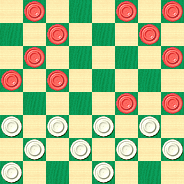The Checker Maven
Jump to navigationThis Way or That Way

Sometimes you have to choose, and the choice isn't always an easy one. This way or that way?
A checker choice that often occurs is "jump this way" or "jump that way" and sometimes the game hangs in the balance. Let's look at the following run-up.
10-14 24-19 11-16 28-24 7-10 22-17 9-13 25-22 5-9 30-25---A 16-20---B 32-28 2-7---C 19-15 10x19 17x10 7x14 (see diagram).
A---Very weak; 24-20 is better.
B---In the original annotations, this move was flagged as the probable losing move; in fact, it's potentially a winning move! However, it takes pretty deep computer analysis to show this.
C---This gives the advantage over to White, while 8-11 would have kept a strong Black lead.

WHITE
White to Play, What Result?
W:W31,29,28,27,26,25,24,23,22,21:B20,19,14,13,12,9,8,6,4,3,1.
White has a choice of jumps. Which is best--- if indeed one is better than the other--- and what result can be expected?
We are obligated to warn our readers that this one is as interesting as it is difficult, and the full solution will probably only be found by top players. But the rest of us can benefit from trying our hand at it. Such practical situations come up all the time.
Make your decision and then click on Read More for the solution and additional analysis.![]()
Solution
The computer initially favors the 23-16 jump, and in the original publication (dating back to 1935) that move was given as a White win. It took substantial and deep computer analysis to demonstrate that the position is a probable draw. For the alternative jump, 24-15, the computer finds a drawing line more easily. Perhaps this might mean that in over the board play, 23-16 would be the better move to make, as it sets Black a harder problem.
Here's the computer's line of play for 23-16, analyzing at five minutes per move.
23x16 12x19 24x15 8-11 15x8 4x11 28-24 6-10 24-19 11-15 19-16 15-19 16-11 19-24 26-23 24-28 11-7 28-32 7-2 32-28 22-17 13x22 25x18 1-6 2-7 10-15 18x11 3x10 29-25 etc. Drawn.
Here's what Walter Hallman gave in analysis that dates back nearly 80 years:
23x16---E 12x19 24x15 8-11 15x8 4x11 28-24 6-10 24-19 11-15 19-16 15-19 16-11 1-5---D and White will win.
D---But Hallman's analysis is incorrect; while 1-5 surely loses, 19-24 holds the draw as shown in our computer solution. Hallman thought that after 19-24 then 22-17 would win for White, but it doesn't (he didn't demonstrate it and the computer still finds a draw).
E---Hallman said 24-15 leads to a narrow draw for Black. We suppose 'narrow' is a relative term.
You can email the Webmaster with comments on this article.
